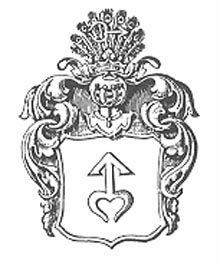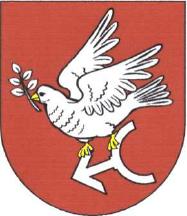

The Sypniewski Coat of Arms
Written and researched by Margaret Odrowaz-Sypniewski

In the book, Galician Nobility, it has Sypniewski (table 449), a Polish family, connected to the Odrowaz coat of arms, still 20 years ago (at the writing of the above stated book) in possession of a sizeable piece of farmland. Coat of arms: Look under Gliscinski III.
Please note: Galicia is in southeastern Poland and was historically part of the Austrian Empire. Galicia was a former province located north of the Carpathian Mountains. It was part of Poland after World War I. After World War II the eastern half (including Lvov/Lemburg) was absorbed into the Soviet Ukraine. The chief town in the Polish section is Krakow.
In Siebmacher's Wappenbuch Prussian Nobility, it lists the arms for Sypniewski (table 269), a family of Polish gentry from the Polish Province (Wojewodztwo/Voivodship) of Prussia, where they were first recorded in 1490. Boniface Sypniewski was matriculated in the nobility records of Galicia in 1783. Coats of arms: Odrowaz.

In Sedziszow Malopolski, the Odrowaz clan coat-of-arms is used as the municipal coat-of-arms. This is because Sedziszow Malopolski was founded by the Odrowaz clan. This information is confirmed in an armorial by Andrzej Plewako and Jozef Wanag called Herbarz Miast Polskich [in English - Armorial of Polish Cities]. This book was published in Warszaw in 1994 [1st edition]. This book has 292 pages. ISBN: 83-213-3568-3

The Odrowaz clan coat-of-arms appears, in 1350,
as the seal of Piotr Sypniewski, Lord Kasztelan/Castellan of Dobrzyn. Dobrzyn Castle, located on the Vistula River, once belonged to The Knights of Dobrzyn or Dobrin. They were called "The Knighthood of Christ" in Livonia. The "Order of Dobrzyn" was founded, in 1228, by the Cisterian Bishop Christian of Prussia, and Duke Corrado of Mazovia. The Order was approved by the Pope in 1228. The Order took its name from the castle of Dobrzyn. By 1235, the Order was incorporated into the Teutonic Knights, and the Order disappeared by 1240. Dobrzyn is currently called Golub Dobrzyn, and is located on the Drweca River in Poland. Originally, it is located in the voivodship of Kujawsko-Pomorskie. The first mention about the village is in 1258. Before this the area was occupied by the Teutonic Knights. This new name came from the fusion of Golubia, situated on the right side of the river and Dobrzyn, that was once a suburb of Golubia. Golubia was located on the opposite bank of the river Drweca.
In 1684, the heir to this area was Zygmunt Dzialynski, the voivode kaliski. In 1721, Zygmunt's son Jacob Dzialynski, owned this property. Then in 1740, Martin Dzialynski was the owner. At last, in 1789, the count Ignatius Dzialynski granted the suburb of Golubskie, by a municipal law, to take the name Dobrzyn, and offered, to the city, his own ancestral coat of arms of Odrowaz. Remember that the Dzialynskis were the descendants of Dobieslaw Sypniewski who had two estates. One was called Dodrzyn, and the other was called Smielchowie. Dobieslaw Sypniewski and his brothers owned various estates called Sypniewo, Smielchowie, Dzwierszno Wielki (large), and Dzwierszno Mal~e (small). Dziewierzno Wielki and Male were both originally owned by Jakub Runge-Sypniewski
Another Sypniewski was Jakub Sypniewski. Jakub was Lord Standard-Bearer of Sieradz. Sieradz is a town on the Warta river in central Poland. It is situated in the Lodz Voivodship (since 1999), and was previously the capital of the Sieradz Voivodship (1975-1998).
Neighbouring Voivodships are:
After 1305, part of the United Kingdom of Poland as a vassal duchy, then after 1339, it was incorporated, by the king Casimir III, "the Great," as the Sieradz Voivodship. From 1327-1339 Przemysl of Cuiavia (Przemysl Kujawski) was the Duke of Sieradz. From 1138-1228, this area was part of the Duchy of Kraków and Sandomierz, and it belonged to the high-dukes of Poland. Poland's Sieradz county is presently part of the Lodzkie Vojvodship.
This information is according to Jozef Szymanski, the author of Herbarz Sredniowiecznego Rycerstwa Polskiego in the "Herbarz S~redniowiecznego Rycerstwa Polskiego" section. In English, this book is the Armorial of the Medieval Chivalry of Poland, and it was published in Warsaw in 1993 [1st edition]. This information can be found on pages 201-203. ISBN: 83-01-09797-3.
In Poland, coats of arms were never provided for individual persons as in England, or for individual families as in Germany, but for a much wider group of people The Polish nobleman added the name of his clan to the family name. In addition to the adjectival surname ending in "ski" or "cki." The standard form was "Piotr Lubomirski, herbu Sreniawa or simply Piotr Sreniawa-Lubormirski." The origin of the names of Polish clans are obscure. Members of the same clan usually fought side by side in battle. In the confusion of battle, it was necessary to have a means of identifying the combatants. The perfect place for arms was on the warrior's shields. They later had banners on lances, as well as markings on their helmets, and knightly coats of armor. From horseback these identifications were even more crucial. Each clan possessed one simple device, one motto, and one coat of arms, which stayed the same throughout the centuries.
Description of the Odrowaz Arms:
These images are in the public domain because according to the Polish Copyright Law Act of February 4, 1994 (Article 4, case 4) "governmental symbols, documents, materials and signs are not subject to copyrights". Hence it is assumed that this image has been released into public domain. However in some instances the use of this image in Poland might be regulated by other laws.
Thanks to Father Bernard Pilarski and Dr. James d'Argantel Odrowaz for helping me translate this section.
RELATED LINKS:
